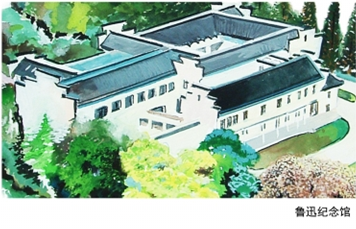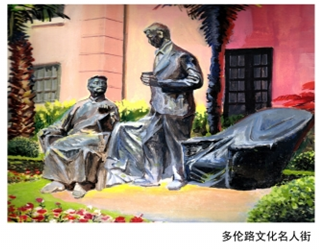Community Resident Paints “Shanghai Tourist Maps” to Record City Development
By Zhang Yanli


With more than 100 maps of Shanghai bought and piled at home, he would still draw maps himself; with thousands of photos taken during the visits to the scenic spots in Shanghai, he would still paint the landscapes himself. That is just the daily life of Cao Yuliang.
Taking the metro around the city just to draw maps
Cao Yuliang, a resident living at the Liangwu neighborhood of the Liangcheng New Village Sub-district in the district, is 83 years old and has a passion for painting. After retirement, Cao and his wife Guo Lanying often visited different places in Shanghai, and gradually he came up with the idea of painting the scenic spots in the city, saying, “In recent years, earth-shaking changes have taken place in Shanghai. As a native of Shanghai, I want to record the upheavals in my own way.”
From 1995 onwards, after each visit, Cao would paint the landscape. Over time, the number of the paintings of the famous scenery with the theme of “New Landscapes in Shanghai” increased to more than 100. Then, another new idea gradually came to Cao’s mind. “I wanted to draw a tourist map for metro tour of Shanghai and display all the scenic spots along the metro lines,” said Cao, explaining that usually taking the metro to travel with his wife he thought the metro was convenient and fast.
In 2000, Cao started his great "project". In order to truly present and depict the scenic spots, he and his wife changed the original carefree “visit for fun” to "field trip". They visited one scenic spot after another, carefully took photos and recorded all the metro lines and station name in each place. "I took thousands of photos and wrote down notes in 5 or 6 notebooks,” recalled Cao.
However, the process of painting was bittersweet, as changes were happening almost moment by moment. It was usual that new landscapes emerged soon after the painting was completed, and the metro lines were always on the rise. The old man had to make adjustments and modifications repeatedly or redesign the layout of the entire painting. In order to keep pace with the progress of Shanghai, Cao usually collected the information and pictures about the new buildings and attractions by watching TV news and reading newspapers. After more than two years of hard work, Cao finally completed the paintings, and contributed them to the Shanghai People's Publishing House. In 2002, the first edition of "Hand Painted Tourist Maps of Shanghai" was published, and in the book 65 scenic spots were hand painted by Cao. In 2015, the publishing house contacted Cao, hoping that he could pick up the painting brush again and update the maps. The old man readily agreed. "In order to paint these, he has continued to buy maps, and we have more than 100 books of Shanghai maps at home now,” revealed his wife Madam Guo.
Booklet witnesses the changing times.
In August 2017, the latest version of the “Hand Painted Shanghai Metro Sightseeing Guide” was published with the number of the hand-painted attractions increased from 65 to nearly 130, including Oriental Pearl Tower, Shanghai Center, the River Mall, Shanghai Port International Cruise Terminal, Shanghai Jewish Refugees Museum, the Memorial Hall of the Fourth National Congress of the Communist Party of China, Astor House Hotel and so on. Under the guidance of the “Hand Painted Shanghai Metro Sightseeing Guide” in touring the city, the visitors can not only experience the modern and prosperous international metropolis but also learn about the history and culture of the “Oriental Paris”.
Holding the booklet containing his hard work in his hands and leafing through the attractions painted by himself, Cao was filled with emotion, saying, “All our good life nowadays depends on the wonderful leadership of the Party!” In November, 1934, Cao was born to a worker's family in Shanghai. His parents were cotton mill workers. When he was young, he witnessed the brutal viciousness of the Japanese aggressors intimidating the mill workers and personally experienced the devastating effects of the old Shanghai. Therefore, Cao cherishes his life very much at present.
Never receiving professional training in art, Cao attributes his high painting skills to passion, diligence and eagerness to learn. At school, he was totally in charge of the blackboard newspaper in the class. After having a job, he took charge of the bulletin boards in the unit. As long as he could draw pictures, Cao always volunteered to rush forward. From 1979 to 1995, Cao created more than 150 cartoons on anti-corruption campaign, which were published in Jiefang Daily, Life Weekly, People's Daily, Outlook Weekly and other newspapers and magazines.
While good at painting, Cao is also "warmhearted", taking an active part in the cultural activities at the community with his painting brush. Li Limin, secretary of the general Party branch at Liangwu neighborhood, said, “In our community a total of 12 murals needed painting on a wall so as to promote the neighborly relations and new trends of civilization. At such an age, Cao not only provided suggestions but also helped us draft the models of the paintings."
“Going forward, I want to focus on our Hongkou District in painting. While I am still able to move around, I will visit the North Bund to paint the beautiful scenery there,” said Cao.